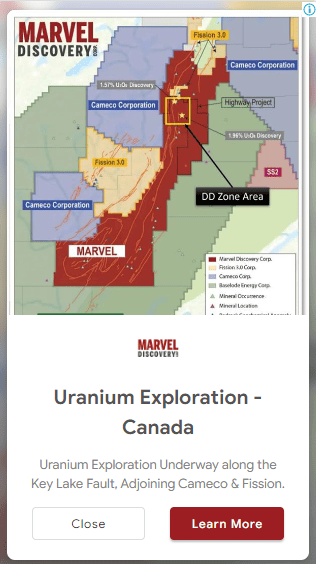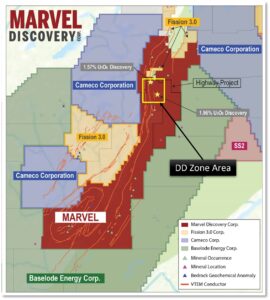2022-02-15 17:13:08
Less than 15% of the six-kilometre strike length of the WGHG has been drill tested near-surface, with most drilling to date limited to less than 120 vertical metres below surface, leaving significant discovery potential at depth.
Matador Mining Ltd (ASX:MZZ, OTCQX:MZZMF)’s interpretation of detailed magnetics, lithogeochemistry and historic data has doubled the known strike length of the highly prospective Window Glass Hill Granite (WGHG) Intrusion to over six kilometres at the Cape Ray Gold Project in Newfoundland, Canada.
New detailed magnetics and bottom-of-hole lithogeochemistry data demonstrate that an untested sheared wedge of the WGHG extends three kilometres further north-east along the Cape Ray Shear Zone (CRSZ) than previously interpreted, immediately north of the 519,000 ounces gold Central Zone mineral resources.
Less than 15% of the six-kilometre strike length of the WGHG has been drill tested near-surface, with most drilling to date limited to less than 120 vertical metres below surface, leaving significant discovery potential at depth.
Great opportunity to test through 2022
Matador Mining executive chair Ian Murray said: “The opportunity presented by the large WGHG system to support significant mineral resource growth within a stone’s throw of the proposed processing facility at Central Zone is extremely exciting.
“To find that the WGHG extends a further three kilometres to the north-east, immediately adjacent to the existing 519,000-ounce gold Central Zone mineral resource, in an area almost completely devoid of previous drilling, represents a great opportunity for Matador to test through 2022.
“Matador will dedicate at least one diamond drill rig throughout the 2022 summer drilling season aiming to grow the WGHG-hosted resources footprint and continue to make new discoveries across the 85% of WGHG area and granite contact zones that are still to be effectively drill tested.
“We will also concurrently advance the broader greenfield discovery efforts and exploration target pipeline.”
For characterising and mapping the critical attributes controlling mineralisation hidden beneath the shallow till cover, this outcome has once again demonstrated the value of:
-
- collecting and interpreting detailed magnetics;
-
- collecting quantitative basement lithogeochemistry data;
-
- questioning historic logging; and
-
- revisiting faded historic map interpretations.
Upside potential
WGHG extension is hosted entirely within the CRSZ and buried under a shallow veneer of till. It has not been rock chip sampled, nor has it been targeted by diamond drilling, representing an exceptional untested structural target for gold mineralisation.
Power auger sampling through till cover, and abundant surface rock chips with more than 1g/t gold in areas of outcrop, demonstrate the potential for vein-hosted gold mineralisation across the entirety of the highly altered and quartz-veined WGHG.
The recent WGHG margin discovery, achieved by using magnetics and geochemistry to “see-through” the till cover, highlights the potential for multiple structurally-controlled gold mineralisation shoots to exist across the large but under-explored WGHG.
To date, there has been no drilling specifically targeting shear-hosted mineralisation in sediments adjacent to the WGHG, which is considered an important mineralised zone in similar granite-hosted gold deposits such as Red 5 Ltd (ASX:RED)’s 6.1 million ounces King of the Hills deposit in Western Australia.
Assays pending from summer drill program
Assay results are imminent from 35 diamond holes drilled during the 2021 summer drilling season, including the following targets:
-
- 10 greenfield diamond drill holes assessing the WGHG Heart-Shaped Pond (HSP) target area. This area, just west of the main WGH Mineral Resource, has never been drilled, however, new Power Auger geochemistry delivered multi-gram bottom-of-hole gold intercepts prompting a reassessment of the target area’s prospectivity;
-
- seven greenfield diamond drill holes testing for along-strike extensions of the WGHG Margin mineralisation to the north-east;
-
- three greenfield diamond drill holes from the Big Pond Area;
-
- 11 infill drill holes within the WGH Mineral Resource; and
-
- four geotechnical drill holes undertaken at Central Zone.
Results are also pending for 1,200 conventional till samples from the Malachite Lake greenfield reconnaissance program and the remainder of the Stag Hill power auger sampling program.








